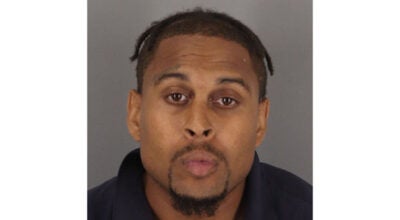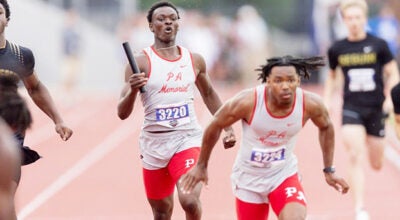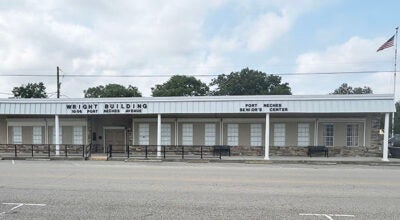Best of West: Little Joe
Published 5:21 pm Wednesday, July 30, 2014
Editor’s note: The following column from the Best of West collection was first published in the Port Arthur News on April 3, 2002.
Little Joe Washington still recalls the moment as if it happened yesterday. A long time follower of the Los Angles Lakers, he was sitting on his couch watching Kareem Abdul-Jabbar, Magic Johnson and company play the Philadelphia 76ers in the early 1980s.
Though he always rooted for the Lakers, the Washington Redskins scatback was doubly interested in the game because of a developing friendship with 76ers star Julius Erving. On this particular night, Erving, or Dr. J as he was known far and wide, would deliver one of his legendary moves that seemingly defied all forces of gravity.
“Julius started down the baseball with Michael Cooper all over him,” recalls Little Joe. “He left his feet at the right side of the free-throw lane, glided all the way under the basket to the other side and laid the ball in. I just sat there with my mouth open. It was one of the few times I’ve been really, really amazed at something I saw at a sporting event.”
Washington, who delivered his share of mind-boggling moves on the football field, now counts Erving as one of his closest friends. Their families often spend Christmas together, they were partners in the first black-owned NASCAR racing team and Erving is coming to town May 18 as part of the Port Arthur News Homecoming Roast saluting Washington.
To basketball fans of middle age and beyond, Dr. J hardly needs an introduction for his visit here. For the Michael Jordan, Vince Carter, Kobe Bryant generation, however, it’s worth spending a column reflecting about a man who will always be on the short list of NBA all-time greats, and who arguably heads an elite cast of skywalkers.
Probably the single greatest testimony to Erving’s mystique and star power was that he almost singlehandedly forced the NBA to reassess the rival ABA after the 1975-76 season.
The upstart ABA, which had signed the Roosevelt, N.Y. native in 1971, after his junior year at Massachusetts, featured other budding stars like Moses Malone, Ricky Barry and David Thompson. But it was the acrobatic feats of the 6-7 Erving which caused the NBA to acknowledge, then finally absorb the brash new league with the red, white and blue basketball, the three-point line and the high-scoring games.
Known as Black Moses and Houdini on the playgrounds in Harlem, Erving’s ability to hang, improvise in midair and deliver crowd-pleasing, jaw-dropping dunks was unlike anything the struggling NBA had ever seen. The only player anyone could even begin to compare with him as 1960s era Laker sensation Elgin Baylor.
Among the best descriptions of Erving’s style came from United States senator Bill Bradley, who had been a member of a New York Knicks championship team in the early ‘70s.
“In a book called Values of the Game, Bradley wrote, “Dr. J took what Elgin Baylor had done and squared it. He not only defied gravity but was a player of such prodigious talent that he could make up his mind what to do while he was in the air, then do it. And all of his fans soared with him.”
Also moved by what he saw in Dr. J was noted author David Halberstam. “Erving dunked with such power, force, grace and originality — each move seemed invented at the very moment he made it — that it was not simply a matter of scoring two points,” penned Halberstam. “His moves electrified not just his teammates but the crowd as well.”
Mostly because of Erving, ABA executives came up with the idea of a halftime slam dunk contest at the 1976 All-Star game. It was in the finals of that contest, against David Thompson, that Dr. J delivered what may have been the most famous dunk in basketball history. After sprinting 45 feet or so, he left his feet at the foul line, brought the ball from behind and, in a helicopter motion, slammed it through the basket.
NBA executives, like the average fan, were blown away and soon made their move.
The ABA-NBA merger brought the San Antonio Spurs, Denver Nuggets, Indiana Pacers and New York Nets into the established league. Erving, at the time, was with the Nets and had been the ABA’s MVP for three consecutive years. Unfortunately for the Nets, they could no longer afford their star. So they traded him to Philadelphia.
He was, of course, an instant success and a boost for sagging NBA TV ratings. Houston fans got an up close and personal look that very first year when Dr. J led the 76ers past the Rockets in the Eastern Conference finals. Erving scored 37 and 34 points in the final two games as the 76ers won in six.
Bill Walton and the Portland Trail Blazers would turn back the 76ers in the NBA finals that year. Despite Erving’s brilliance — he was the league’s MVP in 1981 — it would be 11983 before the 76ers could claim an NBA title. The addition of Moses Malone, the league’s MVP in 1982 with Houston and in 1983 with the 76ers, finally put them over the top.
Erving’s legacy, meanwhile, extends well beyond the NBA championship, one MVP award and a 24.2 career scoring average. A man who exudes class, who has long been considered one of the most eloquent figures in sports, he was a first ballot Hall of Famer and a no-brainer choice to the NBA’s all-time top 50 chosen a few years ago.
It’s certainly going to be an honor to welcome him to Port Arthur.
Sports editor Bob West can be e-mailed at rdwest@usa.net.





